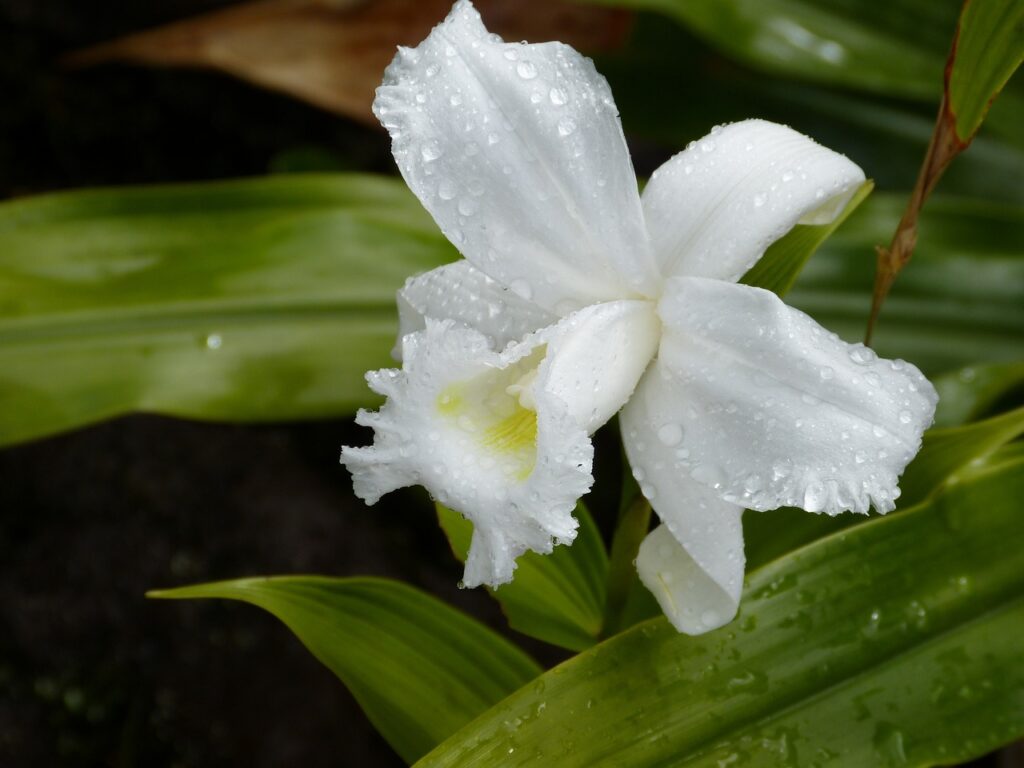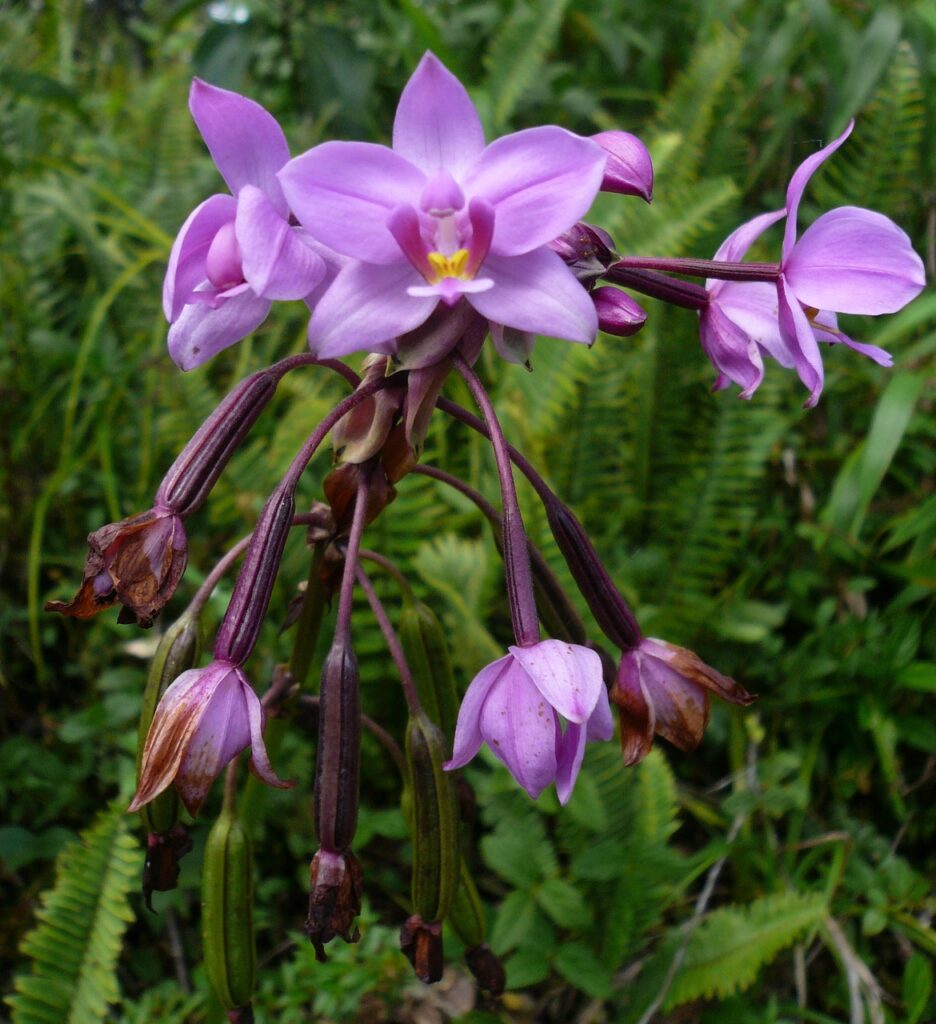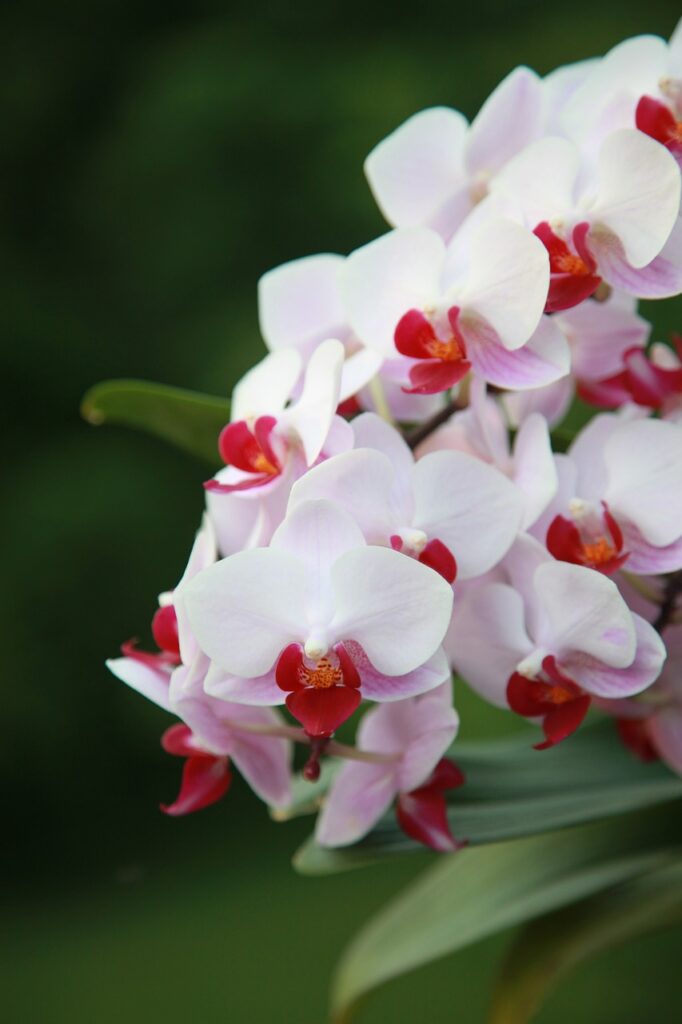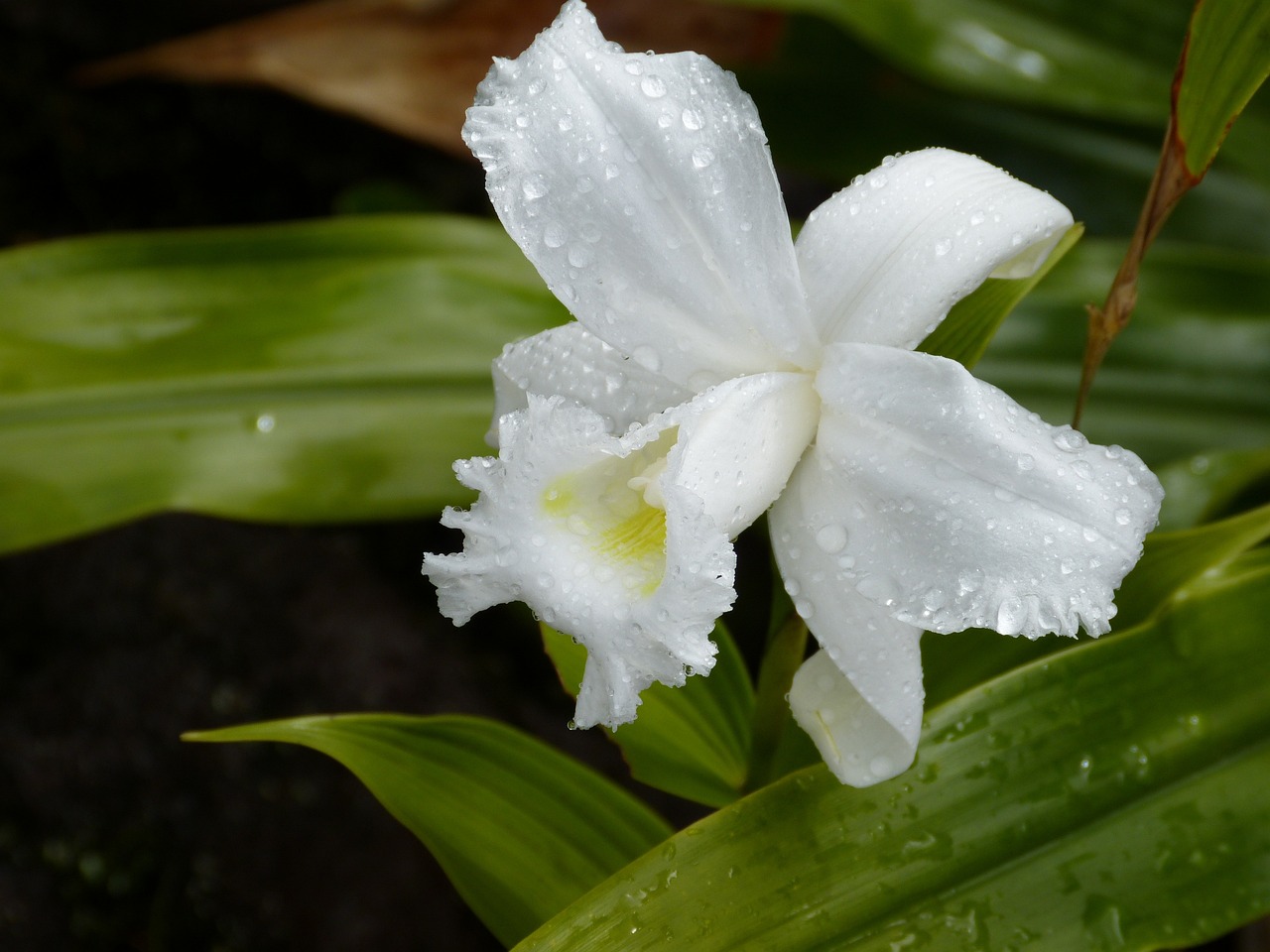Imagine yourself standing in the midst of a lush, vibrant tropical rainforest, surrounded by a breathtaking display of colors and scents. Amidst this exquisite beauty, one group of plants stands out with its delicate blooms and intricate shapes: orchids. In this article, we will take you on a captivating journey through the rich world of orchid flora in tropical rainforests. Get ready to marvel at the diversity and wonder of these enchanting flowers, as we delve into their fascinating adaptations, the ecosystems they thrive in, and the importance of their conservation.

1 Definition of Orchid Flora
Orchid Flora refers to the diverse group of orchids that inhabit tropical rainforests around the world. Orchids are flowering plants that belong to the family Orchidaceae, and they are known for their beauty and intricacy. With over 25,000 recognized species, orchids are one of the largest families of flowering plants on Earth. They come in a wide range of sizes, colors, and shapes, making them a popular choice among plant enthusiasts and collectors.
1.1 Types of Orchids
There are several types of orchids that can be found in tropical rainforests. Some of the most common types include epiphytic orchids, terrestrial orchids, and myrmecophytic orchids.
Epiphytic orchids are those that grow on other plants, such as trees, without being parasitic. They use their aerial roots to obtain nutrients and moisture from the air and rainwater that accumulates in crevices or in the canopy. These orchids often have thick, fleshy leaves and can be found clinging to the trunks and branches of trees.
Terrestrial orchids, on the other hand, grow in the soil and are not dependent on other plants for support. They can be found in various habitats within the rainforest, including forest floors, clearings, and even along riverbanks. Terrestrial orchids have adapted to different soil types, such as loamy or sandy soils, and can thrive in both shaded and sunny areas.
Another interesting type of orchid found in tropical rainforests is the myrmecophytic orchid. These orchids have developed a mutualistic relationship with specific species of ants. The orchids provide the ants with a nesting site and nectar, while the ants in turn provide protection and carry out pollination.
1.2 Importance of Orchids in Rainforests
Orchids play a crucial role in the ecosystem of tropical rainforests. They are not only important for their aesthetic value but also for their ecological significance. Orchids contribute to the overall biodiversity of the rainforest by providing habitats for various organisms, including insects, birds, and other animals. Many orchid species have specialized relationships with specific pollinators, ensuring the survival of both the orchids and the pollinators themselves. Additionally, orchids are often indicators of the overall health and diversity of the rainforest ecosystem. Their presence or absence can provide valuable information about habitat quality and environmental changes.
2 Biodiversity in Tropical Rainforests
Tropical rainforests are renowned for their exceptional biodiversity. They are home to a wide range of plant and animal species, including a remarkable diversity of orchids.
2.1 Overview of Tropical Rainforests
Tropical rainforests are characterized by their high annual rainfall and year-round warm temperatures. They are located in regions near the equator, such as the Amazon Basin in South America, the Congo Basin in Africa, and the Southeast Asian rainforests. These ecosystems are incredibly complex, with multiple layers of vegetation, including emergent trees, canopy trees, understory shrubs, and ground-level plants. This layered structure creates a diverse range of microhabitats, each supporting a unique set of organisms.
2.2 Importance of Rainforests for Orchid Flora
Rainforests provide ideal conditions for the growth and survival of orchids. The high humidity and constant availability of moisture in these ecosystems create a favorable environment for orchids, particularly those that rely on air and rainwater for their nutrients. The dense vegetation and tall trees in rainforests also offer protection and shade, providing the necessary light levels for orchids to thrive. Additionally, rainforests are often home to a wide variety of pollinators, such as bees, butterflies, and hummingbirds, which are essential for the reproduction of many orchid species.

3 Adaptations of Orchids in Tropical Rainforests
Orchids have evolved various adaptations that allow them to survive and thrive in the challenging conditions of tropical rainforests.
3.1 Epiphytic Orchids
Epiphytic orchids have adapted to life on tree trunks and branches by developing specialized structures. Their aerial roots are equipped with velamen, a spongy tissue that can absorb and store water efficiently. This adaptation allows epiphytic orchids to collect and retain moisture from the humid rainforest air. Some epiphytic orchids also have pseudobulbs, which serve as water storage organs during periods of drought. Additionally, epiphytic orchids often have flattened, succulent leaves that help them retain water and reduce water loss through transpiration.
3.2 Terrestrial Orchids
Terrestrial orchids have different adaptations to suit their life on the forest floor. Many terrestrial orchids have tubers or underground storage organs that enable them to survive during dry periods or unfavorable conditions. These tubers store nutrients and water, allowing the orchids to sustain themselves until conditions improve. Some terrestrial orchids also have specialized mechanisms for seed dispersal, such as producing lightweight, feathery seeds that can be carried by the wind or attaching their seeds to the fur or feathers of animals.
3.3 Myrmecophytic Orchids
Myrmecophytic orchids have evolved unique adaptations to attract and house specific ant species. They often have hollow stems, called domatia, which provide nesting sites for ants. In return, the ants protect the orchids from herbivores and help with pollination. Myrmecophytic orchids also produce nectar and other rewards that serve as incentives for ant visits. This mutualistic relationship benefits both parties, ensuring the survival and reproduction of the orchids and providing a source of food and shelter for the ants.
4 Orchid Habitat and Distribution
Orchids have specific habitat requirements that influence their distribution patterns in tropical rainforests.
4.1 Preferred Environmental Conditions
Orchids thrive in environments with high humidity, adequate rainfall, and diffused light. They prefer moist, well-drained soils that retain moisture but do not become waterlogged. Orchids are also highly adaptable and can be found growing in a range of habitats, from shady forest floors to sun-drenched clearings. Different orchid species may have additional preferences for factors such as temperature, elevation, and soil pH, which contribute to their niche specialization within the rainforest ecosystem.
4.2 Global Distribution of Orchids
Orchids can be found in various tropical rainforest regions around the world. Some of the most biodiverse areas for orchids include the Amazon rainforest in South America, the tropical forests of Southeast Asia, and the rainforests of Madagascar and Papua New Guinea. Within these regions, orchids can be found in diverse microhabitats, such as lowland forests, montane forests, and even epiphytic habitats in the tree canopy. The distribution of orchids within a rainforest is often influenced by factors such as altitude, climate, and the presence of specific pollinators or symbiotic partners.

5 Factors Affecting Orchid Diversity
Orchid diversity in tropical rainforests is influenced by a variety of factors, both natural and human-induced.
5.1 Climate and Rainfall
Climate and rainfall patterns play a significant role in determining the distribution and abundance of orchids in tropical rainforests. Orchids require a consistent and reliable source of moisture, as well as specific temperature ranges for optimal growth. Changes in climate, such as extended drought or extreme rainfall events, can have a profound impact on orchid populations. Climate change and deforestation can disrupt the delicate balance of environmental conditions that orchids depend on, leading to declines in orchid diversity.
5.2 Habitat Destruction and Fragmentation
Habitat destruction and fragmentation pose significant threats to orchid flora in tropical rainforests. The conversion of rainforests into agricultural land, logging activities, and urbanization result in the loss of suitable habitat for orchids. Fragmentation of rainforest ecosystems can isolate orchid populations, reducing genetic diversity and limiting gene flow between populations. This fragmentation also disrupts natural pollination processes by reducing the availability of pollinators and limiting the movement of orchid seeds.
5.3 Pollinator Availability
Orchids have developed intricate relationships with specific pollinators, such as bees, moths, hummingbirds, and insects. Changes in pollinator populations or the loss of specific pollinator species can have a direct impact on orchid reproduction and genetic diversity. Habitat destruction, pesticide use, and the spread of invasive species can all disrupt pollinator populations, leading to reduced pollination success for orchids. Maintaining healthy pollinator populations is crucial for the long-term survival of orchids in tropical rainforests.
6 Orchid Conservation and Threats
Conserving orchid flora in tropical rainforests is essential for maintaining overall ecosystem health and biodiversity.
6.1 Importance of Orchid Conservation
Orchids play a vital role in maintaining the ecological balance of tropical rainforest ecosystems. They provide habitats, food sources, and pollination services for a wide range of organisms. Orchids also have significant cultural and aesthetic value and are highly valued in horticulture and floral trades. Their conservation ensures the preservation of natural beauty and the continued availability of genetic resources for scientific research and future generations.
6.2 Threats to Orchid Flora
Orchid flora in tropical rainforests face numerous threats. Habitat loss and habitat degradation due to deforestation, agriculture, and urbanization pose major challenges to orchid conservation. The illegal collection and trade of rare and endangered orchid species also contribute to their decline. Climate change is another significant threat, as shifts in temperature and rainfall patterns can disrupt orchid populations and their associated symbiotic relationships. Invasive species and the decline of pollinator populations further compound the threats faced by orchids.
6.3 Conservation Efforts and Strategies
Several conservation efforts and strategies have been implemented to protect orchid flora in tropical rainforests. These include the establishment of protected areas and national parks to safeguard orchid habitats. Conservation organizations work to monitor and research orchid populations, promote sustainable practices, and raise awareness about the importance of orchid conservation. Initiatives to combat illegal trade and support sustainable livelihoods for local communities are also critical for the long-term conservation of orchids.
7 Medicinal and Economic Importance
Orchids have long been valued for their medicinal properties and economic uses.
7.1 Medicinal Properties of Orchids
Many orchid species have been used in traditional medicine for centuries. They are believed to have various therapeutic properties, including antifungal, anti-inflammatory, and diuretic effects. Orchids have been used to treat ailments such as arthritis, digestive disorders, and respiratory problems. The discovery of bioactive compounds in orchids has led to extensive research on their potential pharmaceutical applications.
7.2 Economic Uses of Orchids
Orchids have significant economic value and contribute to local economies in tropical rainforest regions. They are highly sought after in the horticulture industry for their beauty and fragrance, making them popular choices for cut flowers, potted plants, and ornamental gardens. Additionally, orchids are used in the production of perfumes, essential oils, and natural cosmetics. The trade of rare and exotic orchid species also generates substantial income, although strict regulations and certification systems have been implemented to prevent the illegal trade of endangered species.
8 Orchid Research and Discoveries
Ongoing research and new discoveries continue to expand our understanding of orchid flora in tropical rainforests.
8.1 Collection and Identification of Orchids
Scientists and botanists undertake extensive fieldwork to collect and identify orchid species in tropical rainforests. These expeditions involve documenting and cataloging the various orchid species, as well as their distribution patterns and ecological requirements. Molecular techniques, such as DNA analysis, are also used to study the evolutionary relationships between different orchid species and populations.
8.2 Recent Discoveries in Orchid Flora
Advancements in technology and research techniques have led to numerous recent discoveries in orchid flora. New orchid species are continually being discovered in remote and previously unexplored regions of tropical rainforests. Scientists have also unraveled the intricate relationships between orchids and their pollinators, shedding light on the coevolutionary processes that have shaped these ecosystems. Furthermore, advances in genomics have allowed for the identification and study of specific genes and pathways involved in orchid adaptation and evolution.
8.3 Future Research Directions
Future research on orchid flora in tropical rainforests aims to further uncover the secrets of these fascinating plants. Scientists are focusing on understanding the genetic mechanisms that regulate orchid development, including the factors that control floral morphology and coloration. Additionally, more research is being conducted on the ecological interactions between orchids and their environment, including the roles of fungi in orchid mycorrhizal associations. The development of conservation strategies and sustainable management practices will also be a priority for future research efforts.
9 Orchid Cultivation and Gardening
Growing orchids is a popular hobby and has become a specialized area of horticulture.
9.1 Popular Orchid Species for Cultivation
Numerous orchid species are cultivated for their ornamental value. Some of the most popular orchids for cultivation include Phalaenopsis, Cattleya, Dendrobium, and Oncidium. These species have been hybridized and selected for their vibrant colors, unique flower shapes, and ease of cultivation. Many cultivars and hybrids have been developed to suit different growing conditions and to extend the flowering season. Moreover, the cultivation of native orchid species is gaining attention as a means of conserving threatened species and promoting their sustainable use.
9.2 Orchid Gardening Techniques
Successful orchid cultivation requires specific techniques to recreate the natural conditions that orchids prefer. Orchid enthusiasts use specialized pots or baskets with well-draining growing media, such as orchid bark or sphagnum moss. They carefully control watering and humidity levels, ensuring that the orchids receive adequate moisture without becoming waterlogged. Orchids require bright, indirect light, so gardeners often provide supplementary lighting or place their orchids near windows with filtered light. Additionally, orchids benefit from regular fertilization and temperature fluctuations to mimic their natural growth conditions.
9.3 Challenges in Orchid Cultivation
While orchid cultivation is rewarding, it can also present challenges for beginners. Orchids have specific care requirements, and meeting these needs can be daunting for inexperienced gardeners. Common challenges include overwatering or underwatering, improper lighting levels, and difficulties with temperature and humidity control. Also, some orchid species have specific requirements, such as cooler temperatures or high elevation conditions, making them more challenging to cultivate. However, with proper research, patience, and a willingness to learn, anyone can enjoy the beauty of orchids in their own garden.
10 Orchid Tourism and Conservation Awareness
The beauty and allure of orchids have contributed to the rise of orchid tourism and the promotion of conservation awareness.
10.1 Orchid Tourism and Ecotourism
Many tropical rainforest regions have embraced orchid tourism as a means of promoting local economies and conservation efforts. Orchid gardens, botanical gardens, and nature reserves offer guided tours and educational programs focused on orchid conservation and appreciation. These tourism initiatives provide visitors with an opportunity to explore the diverse orchid flora of tropical rainforests and learn about their significance in the ecosystem. Orchid tourism encourages the sustainable use of natural resources and supports the preservation of orchids and their habitats.
10.2 Role of Orchid Conservation in Tourism
Conservation of orchid flora is closely linked to the success of orchid tourism. Protecting orchid habitats and implementing sustainable management practices ensures the long-term availability of orchids for tourism activities. Conservation efforts also contribute to maintaining the overall biodiversity of tropical rainforests, creating a richer and more ecologically balanced environment for visitors to experience. Orchid tourism helps raise awareness about the importance of conserving these delicate ecosystems and encourages local communities to value and protect their natural heritage.
10.3 Promoting Conservation Awareness
In addition to orchid tourism, various initiatives and organizations are working to promote conservation awareness among the general public. Educational programs, workshops, and outreach campaigns strive to highlight the ecological significance of orchids and the threats they face. These efforts aim to inspire individuals to take action and support orchid conservation through sustainable practices, responsible consumption, and advocacy. Conservation awareness also extends to policy-making and the implementation of regulations and international agreements to protect endangered orchid species and their habitats.
In conclusion, exploring the richness of orchid flora in tropical rainforests is a fascinating journey into the complexities of these diverse and beautiful ecosystems. Orchids, with their unique adaptations and ecological relationships, play an important role in maintaining the biodiversity and ecological balance of tropical rainforests. However, they face numerous threats, including habitat loss, climate change, and the illegal trade of endangered species. Conservation efforts, research initiatives, and sustainable practices are essential for ensuring the survival of orchids and the preservation of these invaluable ecosystems. By appreciating and protecting orchids, we can contribute to the conservation of tropical rainforests and the countless species that depend on them.
